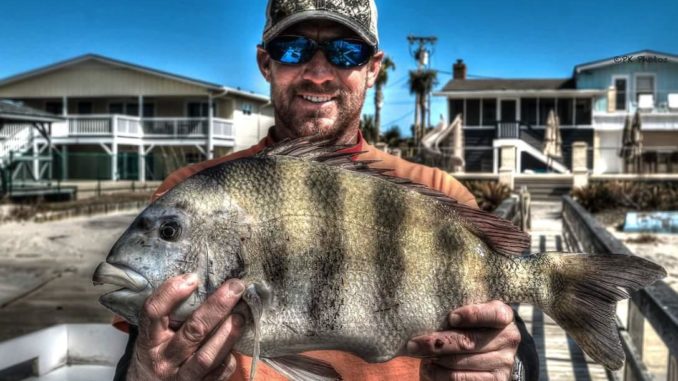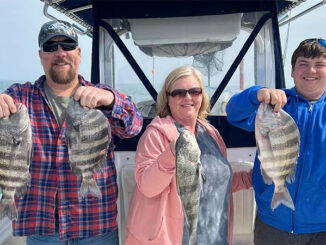
Fiddler crabs drawing plenty of strikes on reefs out to a half-dozen miles or so
The ocean is finally heating up in more ways than one. Not only is the water temperature finally creeping above 50 degrees, the sheepshead bite along the nearshore reefs within sight of the Myrtle Beach skyline is hot, with several captains reporting double-digit catches on a frequent basis.
Capt. Jay Sconyers of Aces Up Fishing Charters is leading the charge, making plenty of short trips to the nearshore reefs to catch these striped bandits.
“We have been doing real well lately,” said Sconyers (843-492-5759). “We caught 18 earlier this week, with two over 5 pounds.”
Throughout the year, sheepshead will nestle around structure, including jetties, pilings or anything that will grow barnacles. For most of the year, jetties and the inshore docks and pilings provide excellent habitat and feeding opportunities for sheepshead. But winter and early spring are different. Sheepshead migrate into the ocean and congregate around the nearshore reefs to spawn.
Even though the reefs’ submerged structure provides opportunities for sheepshead to feed, the rations are somewhat limited in the winter, while huge schools of sheepshead show up. And the sheepshead goes crazy when one of their favorite foods appears right in front of its face.
Sheepshead will eat live shrimp and other crustaceans, but they are not alone at the reefs. Black sea bass, tautog and dogfish will gobble up just about anything. In fact, Sconyers is catching plenty of large black sea bass, black drum and some jumbo tautog in addition to sheepshead.
For the best chances of nailing a sheepshead, Sconyers recommends using fiddler crabs on a weighted rig.
“Fiddler crab on a typical Carolina rig is what we are using. Some other people will use a ½-ounce jig head, but the Carolina rigs work better for us,” he said.
For Sconyers, the typical Carolina rig for sheepshead assembles a 1 ½-ounce egg sinker, a barrel swivel, 18 inches of fluorocarbon leader and an Owner 1/0 Mosquito hook.
“You can use a lighter weight less than 1 ½ ounces and probably get more bites, but the lines will get tangled up when they drift into each other,” he said.
Sheepshead are often referred to as convicts because of their black/white stripes and due to their ability to steal the bait away without being detected. Sconyers uses 30-pound braided line on reel because he feels the added sensitivity helps him detect that faint bite.
“Braided line provides you with added sensitivity, and when you get a 10-pounder, you can crank them in, because sheepshead will take you into the reef immediately after becoming hooked,” he said.
Sconyers uses nearly a foolproof method that helps him detect a bite right at the moment when setting a hook is critical.
“Pull up a little bit and drop back to the bottom in a constant motion, back and forth. When you feel the line heavier, give it a solid jerk to set the hook and hold on,” he said.
Just about any of the nearshore reefs within 15 miles of the beach with adequate structure will collect schools of sheepshead during the winter and early spring. Sconyers recommends the reefs the closest to shore – the Three Mile Reef, North Inlet Reef, Jim Caudle Reef and the Pawley’s Reef.





Be the first to comment